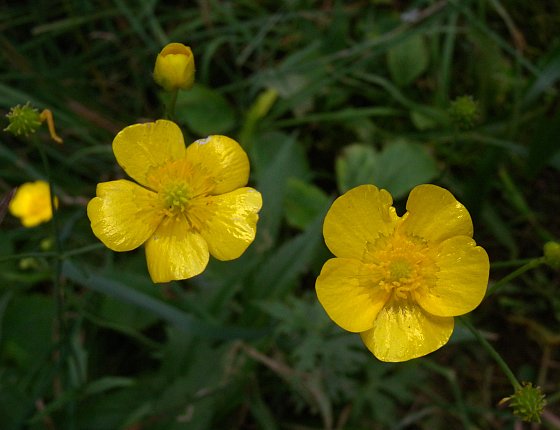
The upper stems terminate into dichotomously branched clusters of flowers; this inflorescence is about ½–2' long. Most flowers in an inflorescence are produced toward its apex. Occasionally, solitary flowers are produced where the long stalks of the inflorescence divide. The pedicels of the flowers are up to 6" long. Both the branches of the inflorescence and the pedicels of the flowers are light to medium green, terete, and variably hairy. Each flower is about ¾–1¼" across, consisting of 5 spreading yellow petals, 5 light green to pale yellow sepals, and a ring of yellow stamens that surrounds a central cluster of light green pistils (or carpels). The petals are orbicular-obovate in shape and overlapping; they are semi-translucent at their bases. The sepals are broadly elliptic, hairy, and widely spreading (not drooping); they are about one-half of the length of the petals. The blooming period occurs from early summer to late summer, lasting about 2 months. Afterwards, the flowers are replaced by dense clusters of achenes about 6-8 mm. across. These achenes are initially light green, but they later become brown. Individual achenes are 2-3 mm. in length, orbicular-obovate in shape, somewhat flattened, and hairless; they have solitary beaks about 0.5–1.0 mm. in length that are curved slightly inward. The root system is fibrous.
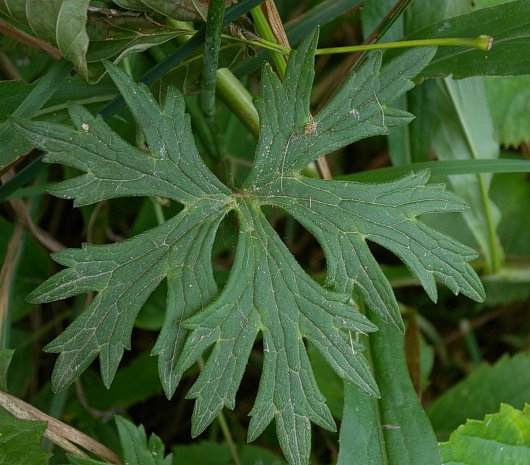
Cultivation: The preference is full sun to partial shade, moist to mesic conditions, and soil containing loam or clay-loam, although other soil types are tolerated. The size of individual plants is strongly influenced by soil fertility and moisture conditions. This species is winter-hardy to at least Zone 4. Cool to warm summer temperatures are preferred.
Range & Habitat: The non-native Tall Buttercup is occasional in NE Illinois, while in the rest of the state it is uncommon or absent (see Distribution Map). This species was introduced into North America from Eurasia as an ornamental garden plant. It is still cultivated in gardens. Naturalized habitats include weedy meadows, woodland borders, stream banks, roadsides, and pastures. Areas with a history of disturbance are preferred. Tall Buttercup sometimes spreads aggressively where cool moist conditions prevail.
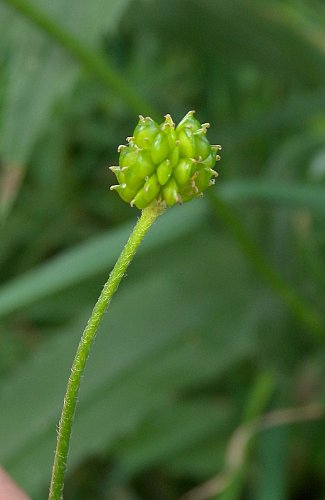
Faunal Associations: The flowers attract primarily bees and flies, including honey bees, Andrenid bees, Halictid bees, Syrphid flies, and Muscid flies (Müller, 1873/1883). Small to medium-sized butterflies and beetles are less common floral visitors. Both nectar and pollen are available as floral rewards. Some insects feed on the leaves, roots, and other parts of buttercups (Ranunculus spp.). These species include leaf beetles (Prasocuris vittata and other Prasocuris spp.), stem-boring and leaf-mining larvae of some Agromyzid flies (Napomyza marginalis, Phytomyza spp.), a plant bug (Mecomma gilvipes), and several aphids, including Rhopalosiphum nymphaeae (Waterlily Aphid), Thecabius affinis (Poplar-Buttercup Aphid), and Thecabius gravicornis (Folded-leaf Balsam Aphid); see Clark et al. (2004), Spencer & Steyskal (1986), Wheeler et al. (1983), Cranshaw (2004), and Blackman & Eastop (2013). Other insects that feed on these plants include the larvae of some sawflies (Monophadnus aequalis, Monophadnus pallescens, and Stethomostus fuliginosus); see Smith (2006).
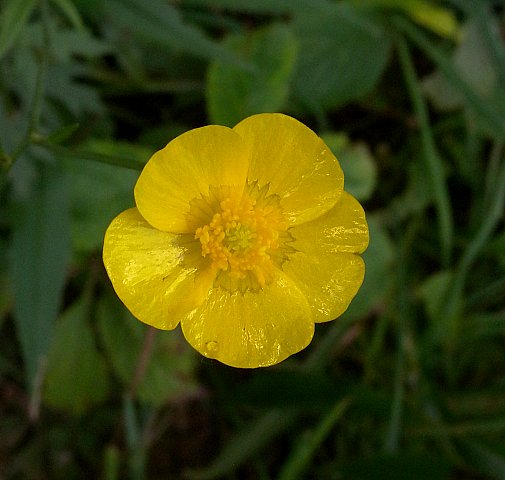
Vertebrate animals use buttercups as a source of food to a minor extent. The seeds are eaten by such birds as the Wild Turkey, Ruffed Grouse, Ring-necked Pheasant, Wood Duck, Mourning Dove, Snow Bunting, and Common Redpoll (Meanley, 1956; Lewis, 1993; Martin et al., 1951/1961). The Ruffed Grouse and Wild Turkey also feed on the foliage. Some small mammals also eat the seeds of these plants, including the Eastern Chipmunk, Meadow Vole, and Woodland Vole (Martin et al., 1951/1961). The acrid foliage is usually avoided by mammalian herbivores because it is toxic from a blistering agent. Its consumption can cause irritation of the internal mouth parts and digestive tract. As a result, Tall Buttercup often increases in pastures in response to grazing by cattle, horses, and other domesticated farm animals.
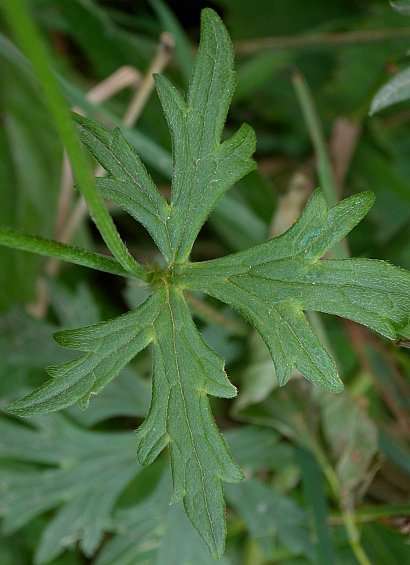
Photographic Location: Border of a woodland along a roadside at Illinois Beach State Park in NE Illinois.
Comments: Tall Buttercup (Ranunculus acris) can be distinguished from similar buttercups (Ranunculus spp.) by its height, the long stalks of its inflorescence and flowers, the relatively large size of its flowers, the overlapping petals of its flowers, and the absence of stalked leaflets on its leaves. Instead, the leaves of Tall Buttercup are deeply divided into palmate lobes that are further divided into secondary and tertiary lobes with acute tips. Across its range, there is some variability in the hairiness of its foliage and the length of the beaks of its achenes. Another common name of this plant is Meadow Buttercup.